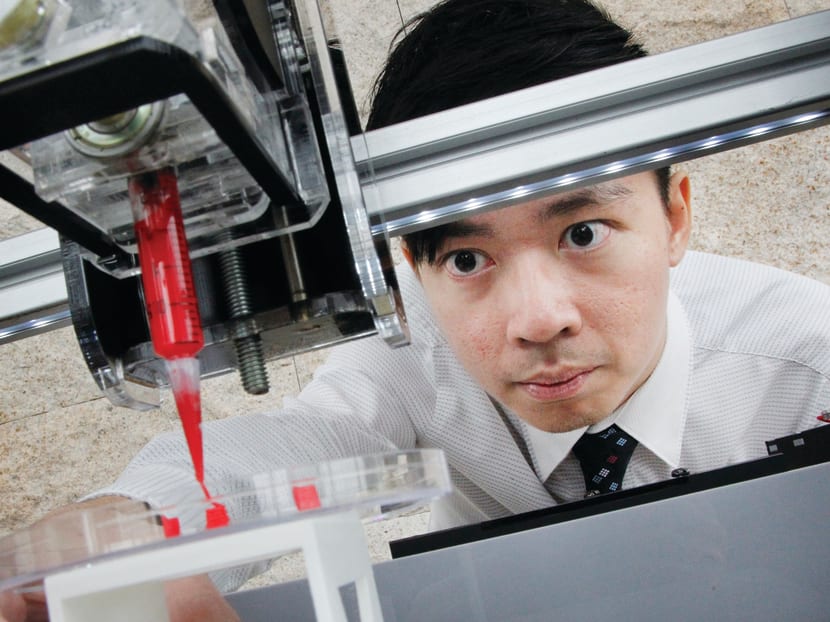Start-up unveils Singapore’s first 3D bio-printer
SINGAPORE — A local start-up has unveiled Singapore’s first 3D bio-printer — able to print biological parts and tissue, which could one day turn out to be a lifesaver, eradicating those interminable waiting lists for organ transplants.

Co-founder and director of Bio3D Technologies, Mr Fan Mingwei, who is a fresh graduate of NTU, with the Life-Printer ‘X’, executing a simulation print of a blood vessel using red bio-gel. PHOTO: DON WONG
SINGAPORE — A local start-up has unveiled Singapore’s first 3D bio-printer — able to print biological parts and tissue, which could one day turn out to be a lifesaver, eradicating those interminable waiting lists for organ transplants.
While 3D bio-printing can already be found in countries such as the United States and the United Kingdom, Bio3D Technologies has been touted as the first to develop such a printer, the Life-Printer “X”, in Singapore.
Conventional 3D printing involves depositing a thin layer of material, typically plastic, layer by layer to manufacture items such as toy figurines and machine parts.
On the other hand, 3D bio-printing uses a different material. Human living cells are first sourced from a patient or purchased from a US biological resource and research company and a suitable number of these cells has to be grown before they can be used to print biological parts and organs, among other things, said the firm’s co-founder and director, Mr Fan Mingwei.
He added that 3D bio-printing employs much higher precision as the biological parts to be printed are smaller and requires a controlled environment conducive for the cells.
But the 29-year-old said although such printers are capable of printing human tissue now, the printing of organs would only be achieved in the next 20 to 30 years as laws and guidelines still need to be set, while further tests and safety trials have to be conducted.
For now, 3D bio-printers are being used to help speed up research and drug development, said Mr Fan. With drug testing, for instance, he said the current process is a lengthy one that involves both animal and human tests. 3D bio-printing would be able to print human tissue for drug testing, shortening the drug development process.
The fresh graduate from Nanyang Technological University’s School of Biological Sciences said he had initially planned to enter the field of conventional 3D printing when it was gaining popularity in the US a few years back.
But Mr Fan, who took a three-year break from his undergraduate studies to focus on his business, found that more were already entering the industry and building their own conventional 3D printers then.
“When I noticed that (the market) would get competitive and saturated, I thought I might as well go into bio-printing. (Biological sciences) is my original field … so I thought of combining 3D printing and biological sciences,” he said.
3D printing gained prominence recently after Prime Minister Lee Hsien Loong made reference to the growing industry when he talked about the future of manufacturing in his National Day Rally speech last year.
The Life-Printer “X” will be officially launched today and the printers are available on lease to interested parties. Rental fees are between S$3,000 and S$10,000 per month, depending on the customisation needed on the system.






